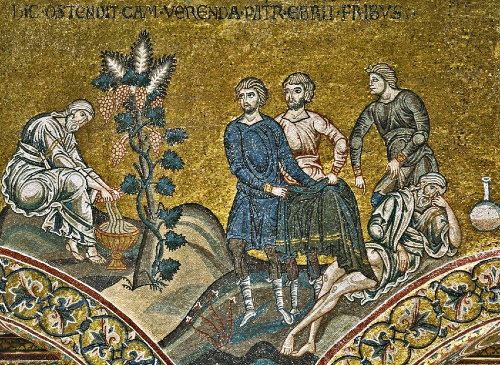In the last article, we considered a sampling of how the gospel writers (or, Jesus, in particular) interpreted Old Testament passages in light of His own life and ministry, seemingly regardless of original historical context. Let us continue this discussion by taking another short sampling of the New Testament writers’ use of Old Testament passages, this time with attention being given to a few particular quotations from Acts and the epistles.
Once again we find that the New Testament authors continue to interpret scripture with Jesus as their central, driving hermeneutic. It is by His life, ministry, death and resurrection that all things enigmatic become clear.
For instance, interpreting Psalm 8 is not particularly difficult. The general understanding is that the human author is contrasting the magnificence of God with the humble estate of human beings, and yet how God has chosen to give humankind an exalted role in caring for His creation. The psalmist is astounded by God’s glory and yet also His desire to incorporate people into the divine plan. Case closed, even satisfyingly so, right? Well, not according to the author of Hebrews.
In Hebrews 2:6-8, the writer quotes directly from Psalm 8:4-6, and then expounds upon who this “son of man” is. After all, for the Hebrew writer, there is ultimately only One who has “everything in subjection under his feet.” This one is none other than Jesus, Himself, for even though everything is not in subjection to Him yet, according to the author, this is in accord with the humble estate He assumed so that “he might taste death for everyone” (2:9) and “having suffered when tempted, he is able to help those who are being tempted” (2:18).
To the author of Hebrews, the key to understanding the psalm’s hidden meaning has been found in Jesus. This is not to say that it did not have a clear meaning in reference to mankind in general, both to its original author and to the first century reader. But the author of Hebrews accepts Jesus’ teaching regarding “all the Scriptures” (Luke 24:27). Only by reading in light of Jesus can the truest meaning be grasped. He now understands that the truest Son of Man is the one made “for a little while lower than the angels,” only to be ultimately exalted in “glory and honor,” namely, Jesus. Paul, himself, incorporates this psalm into his own epistles twice, in 1 Corinthians 15:27 and Ephesians 1:22, both times in reference to Jesus and his supreme authority. Knowing this, why would one ever stop the interpretive process with only the limited understanding of the original author?
In Reflections on the Psalms, C. S. Lewis addresses at some length the interpretive method of seeing Christ in the Psalms in order to understand them most properly. He takes special interest in Psalm 40 and emphasizes that even the statement of v.12—“my sins have taken such hold upon me that I am not able to look up”—should be interpreted Christologically: “But this too is for us the voice of Christ, for we have been taught that he who was without sin became sin for our sakes, plumbed the depths of the worst suffering which comes to evil men who at last know their own evil.”[1] Only by seeing each verse of the Psalm as relating to the Christ-event do we get the fullest possible picture of all that is going on in Jesus’ fulfillment of all the Scriptures. He displays both the greatest heights of submission and righteousness (vss. 8-9) at the same time contrasted with the sinful side of human nature which He assumed in its entirety to bring men to Himself.
In I Corinthians 15, Paul has much to say about the bodily resurrection of believers. Though some may scoff, Paul is completely confident such resurrection will take place. As he nears the end of his extended case for resurrection, he uses a quote directly from Hosea 13:14—“Where, O death, is your victory? Where, O death, is your sting?” Paul uses this quote in a very positive way, as if speaking sarcastically to death, itself, asking where the bite is behind all the bark. Paul is saying death now has no power over the believer thanks to Christ. But the original context of Hosea 13:14 is quite negative (NIV, notwithstanding; compare ESV, NASB). The original author had no sarcastic intent. The entire context before and after the verse in Hosea is one of judgment against Israel/Ephraim. God, it seems, is calling death to come and ravage northern Israel which now awaits judgment. Paul, however, seems to have no qualms about using the quote positively. For Paul, what was judgment for the gravest sins has become redemption through Jesus. Israel (and all mankind) need not be sentenced irretrievably to death. Thanks to Jesus, the threat of death’s eternal grasp is no longer valid and Paul uses the verse in light of that truth.
Another very interesting (and highly suspect to moderns) interpretation has to do with Paul’s approach to the grammatical makeup of one word: seed. In Genesis 13:15 (and other places), God uses the word “seed” to speak of the promises He will bring through Abraham’s offspring. For Paul, it seems to be a particularly big deal that God uses the singular form in Hebrew—“seed,” rather than “seeds.” Paul interprets the Scripture to be written this way because it shows that ultimately God was not talking about a nation of people, but about one person, and that is Christ (Galatians 3:16). It is quite logical to conclude when reading Genesis alone that the original author was talking about a nation of people that will come from Abraham’s progeny. This fact would, by no means, escape Paul with his impeccable Jewish credentials. But, in Christ, he looks through it to an even greater fulfillment. He says that the greatest fulfillment of this passage can only be found in Jesus and the truest understanding of the singular grammatical form of “seed” finds its best interpretation in the one man in whom all who wish to experience the fulfillment of God’s promise must finally find themselves.
What should today’s Bible student take from what has been emphasized in Tip 2? First and foremost, it is obvious that Jesus and the New Testament authors were intentional in prioritizing Jesus’ central role when understanding the heart of any Old Testament passage. Whether Psalms, Prophets, or even the Law, Jesus is the only means to get at the deepest and best meaning of any passage. Also, every story, verse, phrase, and even every single word has a connection to Jesus in which it finds its ultimate fulfillment. “Son of man” may be used in Psalm 8 in parallelism with “mankind,” but it still must be connected to Jesus—the true Son of Man—to discern its greatest meaning. “Seed” in Genesis is without question connected to all the Jewish progeny of Abraham, as a whole, but according to Paul, it will never be fully grasped until the connection to the one Seed through whom all are blessed is made.
Without a doubt, the New Testament writers see Jesus as the great fulfillment of Old Testament scripture. Like stated above, it is not that they are unable to see fulfillment on the level of the historical author and his given setting. But they have been taught by Jesus to relate each passage to Jesus’ life, ministry, death, resurrection, and the subsequent mission to all nations (Luke 24:44-47). To the apostles (and early church fathers, for that matter), trying to interpret a passage without Jesus as the primary interpretive key would be like trying to make chicken soup without ever acknowledging that chicken is the primary ingredient.





